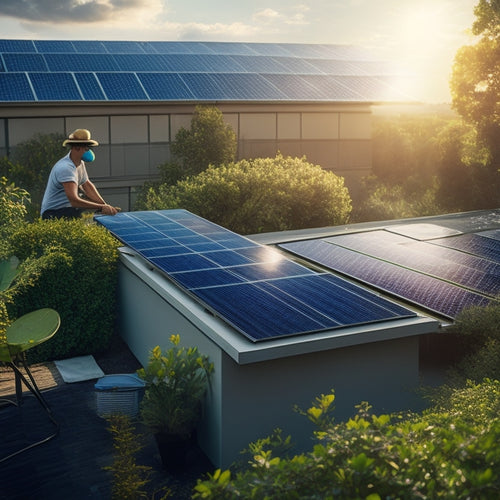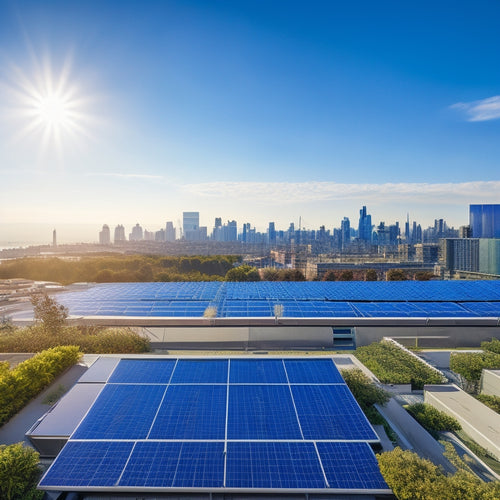
California Home Solar Panel Installation Costs Explained
Share
Understanding the costs of installing solar panels in California means analyzing several variables. Average costs range from $2.68 to $3.38 per watt, influenced by system size, equipment quality, and seasonality. High-efficiency monocrystalline panels command higher prices but offer long-term savings. Labor and permitting fees add another 10-15% to your budget. Don't forget federal and local incentives which could reduce your initial outlay considerably. Financing options like solar loans and PPAs offer flexible terms based on your credit score. If you update your home's energy system, you'll see both immediate and long-term benefits. Discover more detailed insights.
Key Takeaways
- Installation costs range: Average costs are $2.68 to $3.38 per watt, varying by system size, equipment quality, and location.
- Labor and permitting fees: Skilled labor accounts for 10-15% of the budget, with permitting fees ranging from $500 to $2,000.
- Federal and state incentives: The Federal ITC offers a 26% deduction, and California Solar Initiative provides performance-based incentives.
- Seasonal price variations: Prices tend to spike during summer months due to higher demand.
- Types of panels available: Options include monocrystalline (15-20% efficiency), polycrystalline (13-16% efficiency), and thin-film panels for large installations.
Average Installation Costs
https://www.youtube.com/watch?v=wju8WwPmivY
California's average solar panel installation costs hover around $2.68 to $3.38 per watt, depending on various factors such as system size and equipment quality. If you're in coastal areas like Los Angeles or San Francisco, expect higher costs due to increased permitting fees and labor rates. Conversely, inland regions like Fresno or Bakersfield often offer lower installation costs, partly because of less stringent local regulations and lower labor costs.
Seasonal trends also play a substantial role in determining prices. For instance, installation costs can spike during peak summer months. With longer sunny days, demand for solar installations soars, driving up prices. Conversely, during the winter months, you might find more competitive rates as demand wanes. However, the winter season's shorter days might affect your immediate energy capture, but the long-term benefits remain substantial.
Additionally, consider regional incentives and rebates, which vary significantly across California. These can offset some of the higher upfront costs, making solar power more accessible.
Factors Impacting Costs
Several key factors impact the costs of installing solar panels, ranging from system size and equipment quality to regional labor rates and permitting fees. Understanding these variables will empower you to make informed decisions and maximize your investment.
Let's break them down:
-
System Size: Larger systems generate more power but come with higher initial costs. The price per watt typically decreases as system size increases, offering economies of scale.
-
Location Specific Costs: Installation costs vary considerably by region due to differences in local labor rates, permitting fees, and utility incentives. For instance, urban areas in California may have higher labor costs but also more substantial rebates and incentives.
-
Warranty Coverage: High-quality solar panels often come with extensive warranty coverage, which can impact upfront costs. While more expensive initially, these warranties protect you from future costs related to equipment failure or degradation, offering long-term savings.
Solar Panel Types
When evaluating solar panel types, you'll encounter three primary categories: monocrystalline, polycrystalline, and thin-film, each with distinct efficiency rates and cost implications. Monocrystalline panels, known for their high panel efficiency, use pure silicon and boast efficiency rates between 15-20%. While they are more expensive upfront, their longevity and efficiency make them a solid investment. Polycrystalline panels, made from silicon fragments, are less efficient (13-16%) but more affordable, offering a good balance between cost and performance.
Thin-film panels represent the latest technology advancements. They're lightweight, flexible, and can be installed on diverse surfaces. However, they lag behind in efficiency (10-12%) compared to their crystalline counterparts. These panels are ideal for large-scale installations where space isn't a constraint.
| Panel Type | Efficiency Rate |
|---|---|
| Monocrystalline | 15-20% |
| Polycrystalline | 13-16% |
| Thin-film | 10-12% |
Selecting the right panel type hinges on your specific needs and how much you're willing to invest upfront. Prioritize high-efficiency panels if you have limited roof space, but consider thin-film for versatile applications. With continuous technology advancements, expect future options to offer even better efficiency at lower costs.
Labor and Permitting Fees
When considering labor costs, you'll find that skilled installation can account for 10-15% of the total project budget, with rates varying based on system complexity and installer expertise.
Additionally, permitting fees, which can range from $500 to $2,000, depend on local regulations and the scope of your installation.
Understanding these factors is essential for accurate budgeting and project planning.
Labor Cost Breakdown
Breaking down the labor costs for California home solar panel installations, you'll find that labor and permitting fees typically account for 10-15% of the total installation expenses. Understanding these costs can help you make informed decisions and maximize labor efficiency, ensuring your installation is both timely and cost-effective.
Labor costs are influenced by several key factors:
-
Labor Efficiency: Highly skilled technicians can notably reduce labor hours, which in turn lowers your overall costs. Efficient labor means fewer interruptions and a seamless installation process.
-
Installation Timeline: A well-planned installation timeline minimizes the project duration. The quicker the project, the less you'll pay for labor, reducing both direct costs and potential delays.
-
Crew Size and Expertise: A larger, well-coordinated crew can expedite the installation, but it's essential that each member possesses the necessary expertise. Balancing crew size with skill level optimizes both time and cost.
Permitting Process Fees
Understanding the permitting process fees is just as important as labor costs, as these fees can range from $500 to $2,000 depending on your local municipality's requirements and regulations. Managing this aspect of your solar panel installation involves grasping local regulations, which vary widely across California. Each city or county may have its own specific stipulations, impacting both the timeline and cost of your project.
You'll need to account for detailed inspection requirements, which guarantee your system complies with safety and building codes. These inspections typically occur at multiple stages—initial, during installation, and final. The fees associated with these inspections are part of the permitting costs, and they ensure your system is safe, reliable, and eligible for grid connection.
In addition, the permitting process might involve administrative fees for the paperwork and approval stages. These fees can also differ based on the complexity and size of your solar panel system. By understanding these costs upfront, you can budget more accurately and avoid unexpected expenses.
Ultimately, knowing the permitting process fees empowers you, giving you control over your solar investment and helping you achieve energy independence within the framework of local regulations.
Incentives and Rebates
California offers a variety of incentives and rebates that can greatly offset the initial costs of home solar panel installations, making renewable energy more accessible and cost-effective for homeowners. Federal incentives, such as the Investment Tax Credit (ITC), currently allow you to deduct 26% of your solar installation costs from your federal taxes. This significant reduction can make solar energy much more attainable.
In addition to federal incentives, California provides several local rebates which further decrease out-of-pocket expenses. Programs like the California Solar Initiative (CSI) offer performance-based incentives that reward you based on the energy your system generates. These rebates have been instrumental in driving the widespread adoption of solar technology across the state.
To better understand how these incentives and rebates can work for you, consider the following:
-
Federal Investment Tax Credit (ITC): Deduct 26% of your solar installation costs from federal taxes.
-
California Solar Initiative (CSI): Receive performance-based incentives that reward energy production.
-
Local Utility Rebates: Various utility companies offer additional rebates, reducing costs even further.
Financing Options
While incentives and rebates greatly reduce the initial costs, various financing options can further enhance affordability and simplify the process of installing home solar panels. One of the most popular methods is through solar loans, which allow you to spread the cost over several years. Loan terms vary significantly depending on the lender and your credit score, but generally range from 5 to 20 years. The better your credit score, the lower the interest rate, making the investment more attractive.
Another viable option is a home equity loan, leveraging your home's value to secure a lower interest rate. This method can provide substantial savings compared to unsecured loans. Additionally, Power Purchase Agreements (PPAs) and solar leases offer alternatives where you pay for the energy produced rather than the panels themselves.
Here's a comparison of different financing options:
| Financing Option | Typical Loan Terms | Impact of Credit Score |
|---|---|---|
| Solar Loan | 5-20 years | Significantly |
| Home Equity Loan | 10-30 years | Moderately |
| Power Purchase Agreement (PPA) | 20-25 years | Minimally |
| Solar Lease | 20-25 years | Minimally |
Each option has its pros and cons, but aligning your choice with your financial situation and credit score can maximize your benefits. By leveraging these financing options, you can take control, reduce upfront costs, and make the switch to solar energy a reality.
Long-Term Savings
When you invest in home solar panels, you greatly reduce your energy bills, often by up to 70%, according to recent studies.
Additionally, properties with solar installations can see an average increase in value of 4.1%, as reported by Zillow.
These long-term savings make solar panels not just an eco-friendly choice but a financially strategic one.
Reduced Energy Bills
Switching to solar panels greatly reduces energy bills, offering substantial long-term savings through decreased reliance on traditional power sources. By harnessing solar energy, you minimize your dependence on the grid, potentially achieving near-zero utility costs.
Here's how:
-
Energy Storage: With advanced energy storage systems, you can store excess solar power generated during the day for use at night. This guarantees continuous energy supply and maximizes your savings by reducing the need for grid electricity.
-
Net Metering: California's net metering policies allow you to earn credits for the excess energy your solar panels produce and feed back into the grid. These credits can offset future electricity bills, further decreasing your overall energy costs.
-
Reduced Peak Demand Charges: Solar panels generate the most power during peak sunlight hours, coinciding with peak demand periods when electricity rates are highest. By using your solar energy during these times, you avoid higher utility rates and reduce your overall expenditure.
Data indicates that California homeowners can save an average of 70% on their electricity bills over 20 years by switching to solar panels. Embracing solar technology not only liberates you from volatile energy prices but also fosters a sustainable, eco-friendly lifestyle.
Increased Property Value
Investing in solar panels can greatly enhance your property's market value, making it an attractive option for prospective buyers. In California's competitive real estate market, properties equipped with solar energy systems consistently show higher resale values. Data from the Lawrence Berkeley National Laboratory indicates that homes with solar installations sell for an average premium of $15,000 above comparable non-solar properties. This increase in home resale value stems from heightened market demand for eco-friendly, cost-saving technologies among buyers.
When you install solar panels, you're not just adding an energy solution; you're integrating a long-term asset into your home. This asset appeals to environmentally conscious buyers and those looking to mitigate future energy costs. Moreover, the California Energy Commission's mandates for new builds to include solar systems by 2020 have set a precedent, driving market demand even higher for existing properties with solar installations.
Ultimately, the upfront costs of solar panel installation are offset by the substantial increase in your property's value. This strategic investment not only provides immediate energy savings but also ensures long-term financial benefits through enhanced home resale potential. Embracing solar energy aligns with your desire for both economic freedom and environmental sustainability.
Comparing Installers
Evaluating solar panel installers in California requires a thorough analysis of their technical expertise, customer reviews, and cost efficiency. The complexity of photovoltaic systems means that choosing the right installer isn't just about finding the lowest price. High reputation ratings and positive customer reviews indicate reliability and quality workmanship.
When comparing installers, consider these three critical factors:
-
Reputation Ratings: High ratings from industry bodies like NABCEP (North American Board of Certified Energy Practitioners) can be a strong indicator of technical proficiency and ethical business practices.
-
Customer Reviews: Scrutinize online reviews from previous clients to gauge satisfaction levels. Look for consistent themes in feedback, such as timely project completion and effective problem-solving skills.
-
Cost Efficiency: Analyze quotes not just for the bottom-line figures but also for the specifics of what's included—system design, installation, and post-installation support. Cheaper doesn't always mean better; make sure you're getting value for your investment.
Online Purchase Tips
Browsing through the landscape of online solar panel purchases requires a keen eye for detail and a solid understanding of the technical specifications and warranty terms. First, scrutinize product reviews to gauge reliability and performance metrics. Customer feedback often highlights real-world challenges and benefits that manufacturers may not disclose.
Next, focus on warranty terms. A robust warranty can be your safety net, ensuring that both the product and installation are covered. Look for warranties that span at least 25 years for performance and 10-15 years for product defects.
Here's a quick comparison to guide your decision:
| Aspect | Key Consideration |
|---|---|
| Technical Specs | Efficiency, wattage, degradation rate |
| Warranty Terms | Length, coverage details |
| Product Reviews | Reliability, user experiences |
| Cost | Initial outlay, long-term savings |
| Installation | Professional vs. DIY |
Frequently Asked Questions
How Long Does the Solar Panel Installation Process Take From Start to Finish?
From permit approval to installation scheduling, the solar panel installation process typically takes 1-3 months. You'll experience liberation from high energy bills, but timelines can vary based on permit approval efficiency and installation scheduling coordination.
What Maintenance Is Required for Home Solar Panels?
You'll need to clean your panels biannually to maintain efficiency. Most warranties cover system checks and repairs for 25 years. Regular cleaning frequency and understanding your warranty coverage liberate you from unexpected costs and inefficiencies.
Can Solar Panels Be Installed on Any Type of Roof?
Yes, you can install solar panels on various roof materials. However, roof compatibility is essential. Asphalt shingles and metal roofs are ideal, while clay tiles and slate require specialized mounting systems. Verify structural integrity for best performance.
How Do Solar Panels Affect Home Resale Value?
You'd think adding solar panels might lower your property value, right? Ironically, they actually increase it. Homebuyers love energy savings, and data shows properties with solar panels sell faster and at higher prices.
What Should I Do if My Solar Panels Get Damaged?
If your solar panels get damaged, file an insurance claim immediately. Check your warranty coverage for repair or replacement options. Make sure you document the damage thoroughly with photos and detailed descriptions to expedite the process.
Related Posts
-

Solar Power Savings for Environmentally Aware Consumers
Switching to solar power lets you drastically cut your carbon footprint while saving money in the long run. Each kilo...
-

Green Ways to Maintain Solar Panels
To maintain your solar panels sustainably, start with regular inspections to catch potential issues early, enhancing ...
-

Business Solar Investments for Cost-Effective Sustainability
Investing in solar energy is a smart move for your business, providing a solid foundation for cost-effective sustaina...


